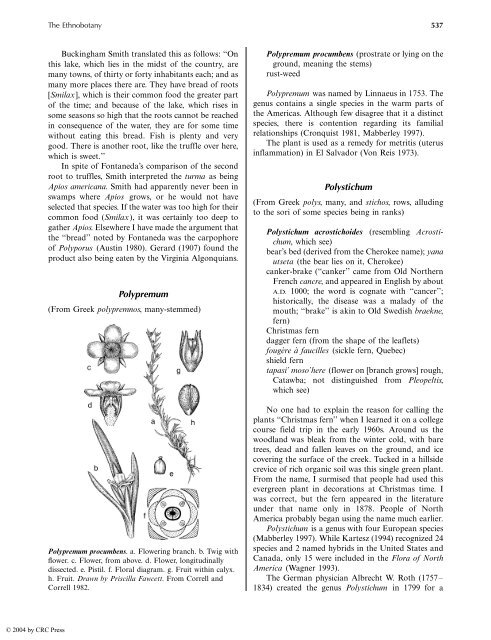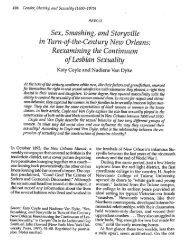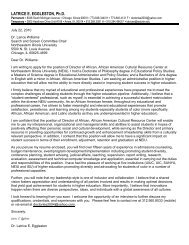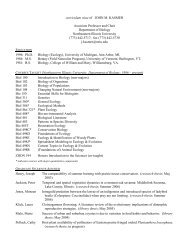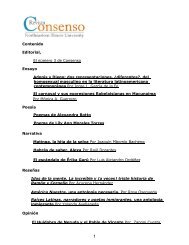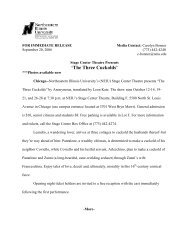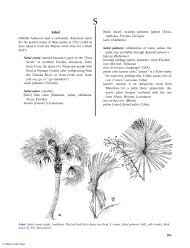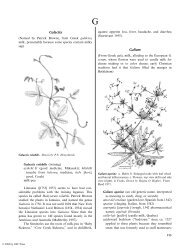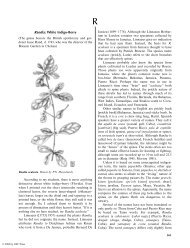Herba Cana - Northeastern Illinois University
Herba Cana - Northeastern Illinois University
Herba Cana - Northeastern Illinois University
Create successful ePaper yourself
Turn your PDF publications into a flip-book with our unique Google optimized e-Paper software.
© 2004 by CRC Press<br />
The Ethnobotany 537<br />
Buckingham Smith translated this as follows: ‘‘On<br />
this lake, which lies in the midst of the country, are<br />
many towns, of thirty or forty inhabitants each; and as<br />
many more places there are. They have bread of roots<br />
[Smilax], which is their common food the greater part<br />
of the time; and because of the lake, which rises in<br />
some seasons so high that the roots cannot be reached<br />
in consequence of the water, they are for some time<br />
without eating this bread. Fish is plenty and very<br />
good. There is another root, like the truffle over here,<br />
which is sweet.’’<br />
In spite of Fontaneda’s comparison of the second<br />
root to truffles, Smith interpreted the turma as being<br />
Apios americana. Smith had apparently never been in<br />
swamps where Apios grows, or he would not have<br />
selected that species. If the water was too high for their<br />
common food (Smilax), it was certainly too deep to<br />
gather Apios. Elsewhere I have made the argument that<br />
the ‘‘bread’’ noted by Fontaneda was the carpophore<br />
of Polyporus (Austin 1980). Gerard (1907) found the<br />
product also being eaten by the Virginia Algonquians.<br />
Polypremum<br />
(From Greek polypremnos, many-stemmed)<br />
Polypremum procumbens. a. Flowering branch. b. Twig with<br />
flower. c. Flower, from above. d. Flower, longitudinally<br />
dissected. e. Pistil. f. Floral diagram. g. Fruit within calyx.<br />
h. Fruit. Drawn by Priscilla Fawcett. From Correll and<br />
Correll 1982.<br />
Polypremum procumbens (prostrate or lying on the<br />
ground, meaning the stems)<br />
rust-weed<br />
Polypremum was named by Linnaeus in 1753. The<br />
genus contains a single species in the warm parts of<br />
the Americas. Although few disagree that it a distinct<br />
species, there is contention regarding its familial<br />
relationships (Cronquist 1981, Mabberley 1997).<br />
The plant is used as a remedy for metritis (uterus<br />
inflammation) in El Salvador (Von Reis 1973).<br />
Polystichum<br />
(From Greek polys, many, and stichos, rows, alluding<br />
to the sori of some species being in ranks)<br />
Polystichum acrostichoides (resembling Acrostichum,<br />
which see)<br />
bear’s bed (derived from the Cherokee name); yana<br />
utseta (the bear lies on it, Cherokee)<br />
canker-brake (‘‘canker’’ came from Old Northern<br />
French cancre, and appeared in English by about<br />
A.D. 1000; the word is cognate with ‘‘cancer’’;<br />
historically, the disease was a malady of the<br />
mouth; ‘‘brake’’ is akin to Old Swedish braekne,<br />
fern)<br />
Christmas fern<br />
dagger fern (from the shape of the leaflets)<br />
fougère à faucilles (sickle fern, Quebec)<br />
shield fern<br />
tapasi’ moso’here (flower on [branch grows] rough,<br />
Catawba; not distinguished from Pleopeltis,<br />
which see)<br />
No one had to explain the reason for calling the<br />
plants ‘‘Christmas fern’’ when I learned it on a college<br />
course field trip in the early 1960s. Around us the<br />
woodland was bleak from the winter cold, with bare<br />
trees, dead and fallen leaves on the ground, and ice<br />
covering the surface of the creek. Tucked in a hillside<br />
crevice of rich organic soil was this single green plant.<br />
From the name, I surmised that people had used this<br />
evergreen plant in decorations at Christmas time. I<br />
was correct, but the fern appeared in the literature<br />
under that name only in 1878. People of North<br />
America probably began using the name much earlier.<br />
Polystichum is a genus with four European species<br />
(Mabberley 1997). While Kartesz (1994) recognized 24<br />
species and 2 named hybrids in the United States and<br />
<strong>Cana</strong>da, only 15 were included in the Flora of North<br />
America (Wagner 1993).<br />
The German physician Albrecht W. Roth (1757 /<br />
1834) created the genus Polystichum in 1799 for a


